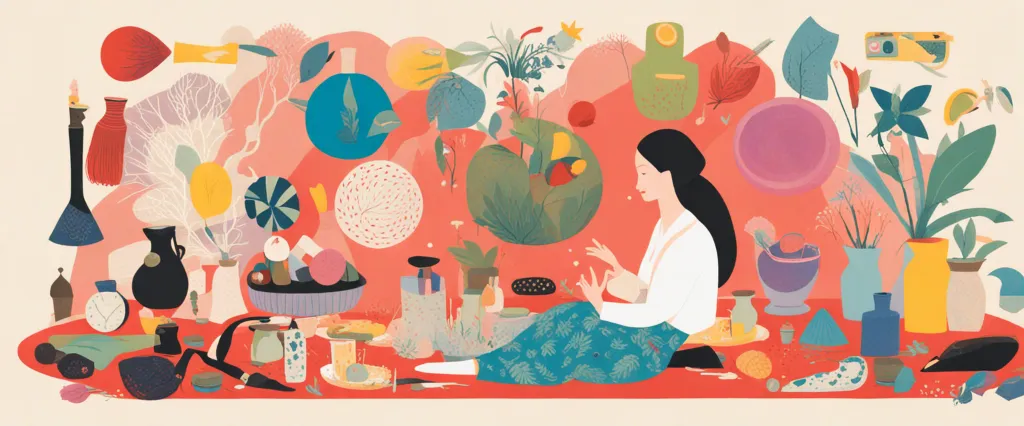In “Spark Joy” Marie Kondo, the renowned Japanese organizing consultant, invites readers to embark on a transformative journey toward tidying and decluttering their homes and lives. Building upon her first best-selling book, “The Life-Changing Magic of Tidying Up,” Kondo guides us with her unique KonMari Method, which aims to create a harmonious, joyful living space by keeping only the possessions that truly spark joy. With her heartfelt dedication to helping others find order amidst chaos, Marie Kondo has become a global sensation, inspiring countless individuals worldwide to embrace the art of tidying up and enrich their lives in the process.
The Magic of Tidying
This sequel presents a more detailed guide on how to incorporate the KonMari method into our daily lives to achieve a clutter-free and joyful environment.
The central concept of the book revolves around the belief that tidying up should be a transformative and joyful experience. Kondō encourages readers to approach tidying as a personal journey, focusing on finding items that truly bring us joy while discarding the rest.
The book provides practical advice on how to organize different categories of belongings, emphasizing the importance of tidying by category, rather than by location. By systematically decluttering our possessions and keeping only what sparks joy, we can create a serene and harmonious living space.
Kondō emphasizes the significance of developing a connection with our belongings and understanding their purpose in our lives. This includes thoughtful folding techniques, such as the signature KonMari fold, which helps maximize storage space while keeping items visible and accessible.
Throughout the book, Kondō shares personal anecdotes and success stories from her clients, highlighting the positive impact of tidying on their lives and relationships.
“Spark Joy” ultimately guides readers toward a minimalist lifestyle, where the home becomes a sanctuary, filled only with items that reflect our values and truly make us happy.
Discarding with Confidence
In this particular section, she emphasizes the importance of confidently discarding items that no longer serve a purpose or bring happiness.
Kondo begins by stressing the significance of being intentional with our possessions. She encourages readers to question each item they own, asking themselves if it truly sparks joy. If not, it is time to let go of it. Kondo argues that holding onto unnecessary belongings only adds to the clutter and prevents one from truly appreciating the items that truly matter.
To discard with confidence, Kondo identifies three key steps. First, she recommends expressing gratitude towards the item before letting it go. This exercise helps acknowledge the purpose it served and allows for a mindful farewell. Next, she suggests considering the future potential of the item. If it can benefit someone else, such as through donation or resale, it can be easier to part with. Finally, Kondo advises envisioning the ideal lifestyle and environment one wishes to create once the tidying process is complete. This vision should provide motivation to discard items that do not align with that ideal.
Furthermore, she acknowledges that discarding can be challenging, especially when there is sentimental value attached. However, she assures readers that letting go of the physical item does not mean letting go of the memories associated with it. Kondo reassures individuals that by discarding with confidence, they can create a more joyful and purposeful living space, free from unnecessary clutter.
By expressing gratitude, considering future potential, and envisioning an ideal living environment, readers can confidently discard belongings, creating a space that truly reflects their happiness and purpose.
Organizing by Category
The first category to tackle is clothing. Kondo advises taking out all clothes and placing them in one large pile, allowing you to visually see the extent of your wardrobe. By holding and assessing each item individually, you can determine whether it truly brings you joy or if it no longer serves a purpose. Once you have decided which items to keep, Kondo teaches a unique folding method that maximizes storage space and allows for easy access.
The second category is books. Like with clothing, Kondo suggests removing all books from shelves and gathering them in one place. Holding each book, she recommends asking yourself if it truly sparks joy or if it’s time to let go. Kondo encourages keeping only those books that you love and will genuinely read again, freeing up space for new and cherished titles.
Next is the category of papers, including bills, documents, and miscellaneous papers. Kondo emphasizes the importance of sorting through these items carefully, discarding anything that is unnecessary or outdated. She provides guidance on creating an effective filing system to maintain order and manage important papers efficiently.
The fourth category to organize is miscellaneous items, such as kitchen gadgets, accessories, and household supplies. By gathering these items together and reviewing them individually, you can identify which ones truly bring joy and which ones have become excess clutter. Kondo provides tips on storage solutions that promote visibility and accessibility.
Finally, sentimental items are addressed. Kondo advises leaving this category until last, as it can be the most emotionally challenging. By reflecting on each sentimental item and appreciating the memories it holds, it becomes easier to decide what to keep and what to let go of. Kondo suggests displaying sentimental items in a way that brings joy and allows you to appreciate them daily.
By organizing our possessions in this specific order, Kondo believes we can declutter with purpose and create a space that truly sparks joy.
Creating a Joyful Home

The book emphasizes the importance of decluttering and tidying up thoroughly and completely, rather than in small increments. It encourages readers to visualize and define their ideal lifestyle, allowing them to determine what truly brings them joy. Kondō suggests starting with clothes, as they are the most tangible belongings and offer a relatively easy starting point.
As readers work their way through the decluttering process, Kondō advises them to hold each item in their hands and ask themselves if it sparks joy. Only items that pass this test should be kept, while those that do not should be discarded with gratitude. Kondō also introduces unique folding techniques to maximize storage space and enable individuals to see and appreciate all their possessions at a glance.
Throughout the book, Kondō stresses the emotional and transformative effects of decluttering, emphasizing that tidying is not just about the act itself but also about creating a home that reflects one’s values and aspirations. By surrounding themselves only with items that bring them joy, individuals can cultivate a positive and uplifting environment that positively impacts their daily lives.
Cultivating a Joyful Mindset
She begins by explaining that joy is the key factor when deciding what to keep and what to discard. Kondō advises readers to hold each item they own and determine whether it sparks joy or not. By recognizing the joy that certain possessions bring, individuals can create a living space that is filled only with items that truly make them happy.
Kondō emphasizes that tidying should be treated as a personal journey. It is not about imposing a set of rules on oneself, but rather about discovering what works best for each individual. She encourages readers to trust their intuition and develop a sense of what truly brings them joy.
Furthermore, Kondō emphasizes the importance of gratitude. Expressing gratitude towards the items that are being discarded helps individuals let go and move on. She suggests thanking each item for its service before letting go of it. This practice fosters a positive and grateful mindset, which ultimately leads to a more joyful and clutter-free space.
Lastly, Kondō highlights the transformative power of tidying and emphasizes that the effects go beyond just physical decluttering. By tidying their living space, individuals gain clarity, peace, and a greater sense of self-awareness. They become more in tune with their environments and are able to create an atmosphere that truly sparks joy in their lives.
Cherishing Sentimental Items
Kondo advises individuals to begin by selecting sentimental items that truly spark joy and evoke positive emotions. She encourages readers to hold each item and ask themselves if it truly brings happiness to their lives. If the answer is yes, then the item should be kept.
Kondo also recommends assigning a specific place for each sentimental item rather than storing them away in a box. By giving sentimental objects their own designated space, individuals can fully appreciate and enjoy them on a regular basis. This also helps avoid clutter and disorganization.
When dealing with large collections of memorabilia, Kondo suggests carefully curating and displaying only the most meaningful items. She advises taking photographs of sentimental items that are difficult to store or that may deteriorate over time, as this allows individuals to preserve the memories without cluttering their living space.
Furthermore, Kondo provides guidance on how to respectfully let go of sentimental items that no longer bring joy. She acknowledges the difficulties associated with parting ways with certain objects but reassures readers that letting go can create space for new memories and experiences.
This approach allows sentimental items to become a vital part of the home’s ambiance, reminding individuals of their most treasured memories and experiences.
Tidying with Family
She encourages readers to involve their family members in the tidying process, as it promotes unity and shared responsibility.
Kondo highlights that tidying is not just a personal endeavor but a collective effort that should involve all household members. By involving everyone, it ensures that everyone’s belongings are respected and that everyone has a say in the organization of the home. She suggests conducting family meetings to discuss the tidying process and to establish clear goals and expectations.
Furthermore, Kondo emphasizes the importance of considering individual preferences when organizing. She encourages family members to determine what items bring them joy and to discard or donate those that no longer serve a purpose. This helps create an environment where everyone feels comfortable and satisfied with their living space.
Kondo also provides practical tips for organizing shared spaces. She suggests using storage solutions that are easy to access and visually pleasing to maintain order. Additionally, she recommends labeling items and storage areas to ensure that everyone can easily find and return belongings to their designated places.

Sustaining the Joyful Life
“The central theme of “Spark Joy” revolves around the concept of only keeping items that “spark joy” in one’s life. Kondo encourages readers to approach the tidying process with a mindset of gratitude and mindfulness, urging them to handle and appreciate each possession individually before deciding whether to keep or discard it. By following this principle, individuals can eliminate the unnecessary clutter that fills their living spaces and ultimately contribute to a happier, more fulfilling life.
Kondo provides practical tips and techniques throughout the book to help readers achieve and sustain the results of their tidying efforts. She guides readers through each category of belongings, such as clothing, books, papers, and sentimental items, offering guidance on how to sort, organize, and store each category in a way that promotes ease of use and maintains tidiness.
One unique aspect of Kondo’s approach is her emphasis on folding clothes in a specific manner to optimize space and visibility. She offers step-by-step instructions on how to fold everything from shirts to socks, enabling readers to achieve neat and tidy drawers that bring joy to their everyday routines.
By implementing the principles and techniques described in the book, individuals can create an organized and harmonious living space that reflects their values and promotes a more joyful life.
After Reading
In conclusion, “Spark Joy” by Marie Kondō offers readers invaluable insights and practical tips on decluttering and organizing their living spaces. The book emphasizes the importance of surrounding oneself with items that truly bring joy and discarding things that no longer serve a purpose. Kondō’s method, known as the KonMari method, encourages individuals to tidy up their homes by category rather than by location. By following her step-by-step guidance and applying her principles of tidying, readers can experience not just a tidier home, but a transformative change in their mindset and overall well-being. “Spark Joy” invites readers to reconsider the relationship they have with their belongings, leading to a more intentional and joyful way of living. With its practical advice and inspiring anecdotes, this book is a must-read for anyone seeking a clutter-free and harmonious living environment.
1. The Power of Now” by Eckhart Tolle: This book explores the concept of living in the present moment and reveals how it can free us from anxiety and suffering. Like “Think Like a Monk,” it provides practical advice on how to cultivate mindfulness and find inner peace amidst the chaos of everyday life.
2. Atomic Habits” by James Clear: In a similar vein as “Essentialism,” this book delves into the importance of focusing on the essential actions that will lead to significant personal and professional growth. Clear outlines strategies for building and breaking habits, helping readers understand the power of small incremental changes to achieve transformational results.
3. Man’s Search for Meaning” by Viktor E. Frankl: Drawing upon his experiences as a Holocaust survivor, Frankl explores the search for meaning and purpose in life. This profound book offers valuable insights on how to find significance even in the most challenging circumstances, providing a powerful perspective on personal growth and resilience.
4. The Art of Learning” by Josh Waitzkin: Similar to “How to Read a Book,” this book delves into the art of learning itself. Waitzkin, a former chess prodigy and martial arts champion, shares his experiences and techniques for mastering new skills. It offers readers an insightful approach to becoming more efficient learners and embracing the process of growth.
5. “The Happiness Project” by Gretchen Rubin: As Marie Kondo’s “Spark Joy” focuses on tidying up and organizing our physical spaces, “The Happiness Project” does the same for our emotional and mental well-being. Rubin shares her year-long journey to cultivate happiness by implementing small changes in various areas of her life. It provides practical advice and thought-provoking insights, inspiring readers to find joy and meaning in their own lives.
These five books offer a diverse range of perspectives and practical wisdom to help readers explore different aspects of personal growth, mindfulness, purpose, learning, and happiness. Each book provides unique strategies and techniques to develop a fulfilling and balanced life, creating a well-rounded reading experience.




